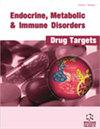蓼属植物甲醇芽提取物的植物成分对高胆固醇血症相关神经退行性病变的神经保护作用
IF 2
4区 医学
Q3 ENDOCRINOLOGY & METABOLISM
Endocrine, metabolic & immune disorders drug targets
Pub Date : 2024-04-04
DOI:10.2174/0118715303283666240319062925
引用次数: 0
摘要
背景:小分子植物化合物有可能改善脑组织的退行性变化。因此,本研究旨在评估高胆固醇血症相关神经退行性病变中 Calligonum polygonoides L. 的甲醇嫩枝提取物(MSECP)的植物化合物的神经保护功效。 背景:高胆固醇血症相关神经退行性病变是心血管疾病的主要并发症:高胆固醇血症相关神经变性是心血管疾病(CVD)的主要并发症。方法:通过 LCMS/MS 对提取物进行植物化学筛选,并通过化学库进行验证。通过腹腔注射 poloxamer-407 和高脂肪饮食诱发高胆固醇血症。通过分子对接、ADME 和分子动力学方法完成了室内评估。MMPBSA 和 PCA(主成分分析)对分子动力学模拟进行了分析。因此,体内研究是通过脂质代谢、清除自由基能力和脑组织(皮层和海马)的组织病理学进行的:研究主要化合物对目标酶(AChE 和 BuChE)的抑制作用和清除自由基的能力。结果:通过 LCMS/ MS 检验发现,试验提取物中含有 22 种主要植物化合物。分子对接评估了三乙酸芹菜素与目标蛋白(HMGCR(HMG-CoA 还原酶)、AChE-乙酰胆碱酯酶和 BuChE-丁酰胆碱酯酶)之间的重要相互作用。分子动力学通过评估 100 ns 时的回旋半径、RSMD、RSMF 和 SASA 对相互作用进行了检验,并通过 MMPBSA(分子力学泊松-波尔兹曼)和 PCA(主成分分析)对其进行了进一步分析。结果表明,试验提取物能显著改变血脂谱、血脂异常指数、抗氧化剂水平和脑组织的组织病理学。结论可以得出结论,三乙酸芹菜素是 MSEPC 的一种强效植物成分,能与 HMGCR、AChE 和 BuChE 相互作用,从而改善高胆固醇血症,同时改善大脑皮层和海马的神经保护功能。本文章由计算机程序翻译,如有差异,请以英文原文为准。
Neuroprotective Efficacy of Phytoconstituents of Methanolic Shoots Extract of Calligonum polygonoides L. in Hypercholesterolemia-associated Neurodegenerations
Background: Small molecule phytocompounds can potentially ameliorate degenerative changes in cerebral tissues. Thus, the current study aimed to evaluate the neuroprotective efficacy of phytocompounds of methanolic shoots extract of Calligonum polygonoides L. (MSECP) in hypercholesterolemia-associated neurodegenerations. background: Hypercholesterolemia-associated neurodegenerations are leading complications in cardiovascular diseases (CVD). Methods: Phytochemical screening of the extract was made by LCMS/MS and validated by a repository of the chemical library. The hypercholesterolemia was induced through the intraperitoneal administration of poloxamer-407 with a high-fat diet. The in-silico assessments were accomplished by following the molecular docking, ADME and molecular dynamics. MMPBSA and PCA (Principal Component Analysis) analyzed the molecular dynamics simulations. Consequently, in-vivo studies were examined by lipid metabolism, free radical scavenging capabilities and histopathology of brain tissues (cortex and hippocampus). objective: To examine target enzymes (AChE and BuChE) inhibition and free radicals scavenging capabilities by leading compound. Results: 22 leading phytocompounds were exhibited in the test extract, as revealed by LCMS/ MS scrutiny. Molecular docking evaluated significant interactions of apigenin triacetate with target proteins (HMGCR (HMG-CoA reductase), (AChE-Acetylcholinesterase) and (BuChE- Butyrylcholinesterase). Molecular dynamics examined the interactions through assessments of the radius of gyration, RSMD, RSMF and SASA at 100 ns, which were further analyzed by MMPBSA (Molecular Mechanics Poisson-Boltzmann) and PCA (Principal Component Analysis). Accordingly, the treatment of test extract caused significant alterations in lipid profile, dyslipidemia indices, antioxidant levels and histopathology of brain tissues. Conclusion: It can be concluded that apigenin triacetate is a potent phytoconstituent of MSEPC and can interact with HMGCR, AChE, and BuChE, which resulted in improved hypercholesterolemia along with neuroprotective ameliorations in the cortex and hippocampus.
求助全文
通过发布文献求助,成功后即可免费获取论文全文。
去求助
来源期刊

Endocrine, metabolic & immune disorders drug targets
ENDOCRINOLOGY & METABOLISMIMMUNOLOGY-IMMUNOLOGY
CiteScore
4.60
自引率
5.30%
发文量
217
期刊介绍:
Aims & Scope
This journal is devoted to timely reviews and original articles of experimental and clinical studies in the field of endocrine, metabolic, and immune disorders. Specific emphasis is placed on humoral and cellular targets for natural, synthetic, and genetically engineered drugs that enhance or impair endocrine, metabolic, and immune parameters and functions. Moreover, the topics related to effects of food components and/or nutraceuticals on the endocrine-metabolic-immune axis and on microbioma composition are welcome.
 求助内容:
求助内容: 应助结果提醒方式:
应助结果提醒方式:


